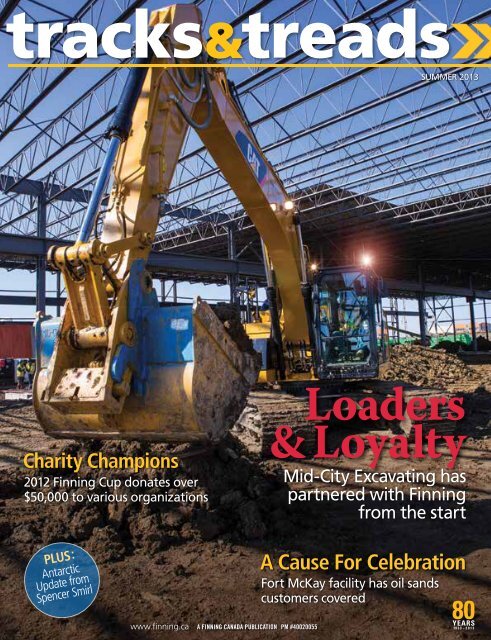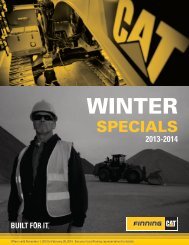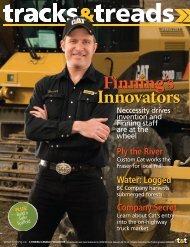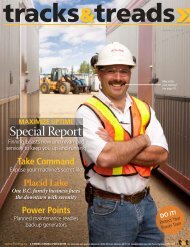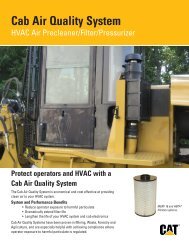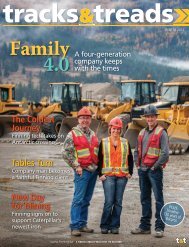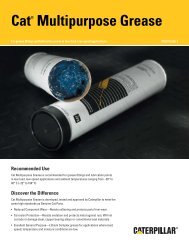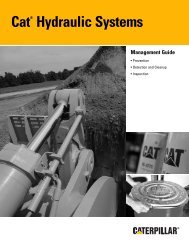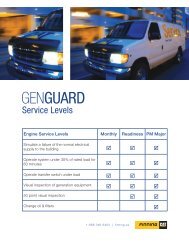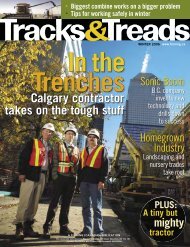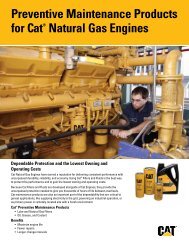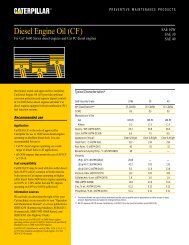Summer 2013 (4.43MB, PDF) - Finning Canada
Summer 2013 (4.43MB, PDF) - Finning Canada
Summer 2013 (4.43MB, PDF) - Finning Canada
- No tags were found...
You also want an ePaper? Increase the reach of your titles
YUMPU automatically turns print PDFs into web optimized ePapers that Google loves.
SUMMER <strong>2013</strong>Charity Champions2012 <strong>Finning</strong> Cup donates over$50,000 to various organizationsA Cause For CelebrationFort McKay facility has oil sandscustomers coveredwww.finning.caA FINNING CANADA PUBLICATION PM #40020055
A DYNAMICADVANTAGEDynamic Gas Blending –your dual-fuel solution forland drilling and production.Learn more about the advantages of making theswitch to Dynamic Gas Blending. Scan the tagor visit http://cc685.com/3500_dgb today.<strong>Finning</strong> Power SystemsEdmonton: 780-443-7500Calgary: 403-275-3340Toll Free: 1-888-finning©2012 Caterpillar. All rights reserved. CAT, CATERPILLAR, their respective logos, “Caterpillar Yellow”and the “Power Edge” trade dress, as well as corporate and product identity used herein, aretrademarks of Caterpillar and may not be used without permission.
Keep Safety's DrumbeatAlive This <strong>Summer</strong>by hilary anaka,finning editorThe "S" word is heard often at <strong>Finning</strong>,but there is a good reason for thatTruth be told, when I first joined <strong>Finning</strong> in 2010I didn’t really get all the fuss about safety. As far asI could tell I was in a low-risk situation. I worked inan office, had common sense and grew up on a farmsurrounded by large equipment. Surely that would beenough to see me through.Three years later, I get it. I’ve seen the light andI’m an advocate. Not a day goes by at <strong>Finning</strong> withouta conversation about safety. Sometimes it’s a safetyshare at the start of a meeting,other times it’s writingan article or reporting anear-miss, but most often it’sabout something that happenedon the weekend or after work hours. Whetherit’s avoiding wildlife on the drive home or slippingon the deck over the weekend, with each story toldmy risk tolerance drops and my desire to spread theword increases.I grew up on a family farm northeast of Edmontonwith my parents and older brother. For most of myyouth, our operation consisted of grain farming andraising cattle. At the height of harvest, racing againstMother Nature to get the crops off, we operated onvery little sleep and under a lot of stress, sharingdusty gravel roads and undivided highways with hundredsof others in the same situation. My family is farfrom reckless but, looking back, our safety practiceswere a bit lax. Thanks to heightened safety awarenessin western <strong>Canada</strong>, improved technology andthe lessons I learn at work, my family is more vigilanteach year.Still, the stark reality remains, according toAlberta's Occupational Health and Safety, every yearthere are employees who don’t make it home fromwork. In 2011 there were four workplace fatalitiesin the Yukon, 18 in the Northwest Territories andNot a day goes byat <strong>Finning</strong> without aconversation about safety.Nunavut, 123 in Alberta and 190 in British Columbia.The numbers paint a distressing picture, but the truetragedy is in the hearts of the loved ones left behind.In early April, a serious injury took the life ofFrancisco Palominos, a 29-year-old employee at<strong>Finning</strong>’s truck shop near Santiago, Chile. Thoughwe’d never met him or worked alongside him, wemourn his passing here in <strong>Canada</strong>. We’re thinkingof his family, friends and co-workers and are doublycommitted to safety – at work and at home.So, in honour of Francisco, and every otheremployee who never made it home; enjoy yoursummer safely. tracks & treads <strong>Summer</strong> <strong>2013</strong>www.finning.ca
SUMMER <strong>2013</strong> Volume 54, No. 2PublisherRuth Kellyrkelly@venturepublishing.caFiNNiNG editorHilary Anakahanaka@finning.caAssociAte PublisherJoyce Byrnejbyrne@venturepublishing.cadirector oF custom coNteNtMifi Purvismpurvis@venturepublishing.caeditorJordan Wilkinsjwilkins@venturepublishing.caeditoriAl AdvisorsJeff Howard,Michelle LoewenArt directorCharles Burkecburke@venturepublishing.caAssociAte Art directorAndrea deBoerAssistANt Art directorColin SpenceProductioN coordiNAtorBetty-Lou SmithProductioN techNiciANsBrent Felzien, Brandon HoovercirculAtioN coordiNAtorKaren Cranecirculation@venturepublishing.caAdvertisiNG rePreseNtAtiveAnita McGillisamcgillis@venturepublishing.cacoNtributiNG WritersStacey Carefoot, Caitlin Crawshaw, David DiCenzo, Keith Haddock,John Hardy, Sandy Joe Karpetz, Trica Radison, Scott Rollans,Robin SchroffelcoNtributiNG PhotoGrAPhers ANd illustrAtorsBuffy Goodman, Greg Halinda, Heff O'Reilly, Kelly Redinger,Rick Tolhurst, Eugene Uhuad, Chip ZdarskiTracks & Treads is published to provide its readers withrelevant business, technology, product and serviceinformation in a livelyand engaging manner.Tracks & Treads is published for<strong>Finning</strong> <strong>Canada</strong> byVenture Publishing Inc.10259-105 StreetEdmonton, Alberta T5J 1E3Phone: 780-990-0839Fax: 780-425-4921Contents © <strong>2013</strong> by <strong>Finning</strong> <strong>Canada</strong>. No part of this publicationshould be reproduced without written permission.PM #40020055deAr trAcks & treAds:Many years ago I was fired because of a Caterpiller machine. I wasworking on a service rig southeast of Edmonton just outside of Brashaw.I was there the day President John F. Kennedy was shot. I was on thegraveyard shift and I didn’t get much sleep before coming to work,probably because I was glued to the assassination reports all overtelevision and radio. It was freezing outside but we had this one reallytoasty shack to keep us warm. No, it wasn’t the boiler. The shack had awonderful and trusty D311 Cat generator in it.I loved the sound of it chugging away at 1200 rpms. It was very warmand inviting to all of us on the rig. At the time, we were drilling out acement plug, so there wasn’t much to do. I decided to go inside thatwarm shack and sit on a pail right next to the D311. I rested my headagainst the engine and the vibration lulled me off to sleep. When I awokeand ventured outside, everyone was wondering where I went. The crewfigured I’d quit and walked right off the jobsite. I guess I may as well havebecause they ran me off just the same. If it hadn’t been for that D311,I probably would have kept the job (mind you I’d have been half-frozenthe whole time).Sincerely,Forbes CampbelldeAr trAcks & treAds:This photo was taken in 1954 at Fords Cove on the Portland canal. Thiswas our very first Cat 8R-D8. Blood, mud and payments of $10 per hourplus fuel was the game back then but things got better. We carried on foranother 50 years. <strong>Finning</strong> has always been a fine company. Just thought I’dshare this; I always look forward to the next issue of Tracks & Treads.Tex FosberyPresidentFosbery Bros. Enterprisestell us what you thinkTracks & Treads would love to hear from you. Tell us what you thinkof the magazine’s stories, columns and look, so that we can improveit and make it a more interesting read.Send your comments to editor-in-chief Hilary Anaka by email athanaka@finning.ca or the old-fashioned way to: Hilary Anaka, Tracks & Treads,<strong>Finning</strong> <strong>Canada</strong>, 16830 – 107 Avenue, Edmonton, Alberta T5P 4C3www.finning.cawww.finning.ca<strong>Summer</strong> <strong>2013</strong>
By David DiCenzoDevastated by FireCharities Are the Real Winnersof the <strong>Finning</strong> CupNon-profit organizations throughout western <strong>Canada</strong>benefited from <strong>Finning</strong>’s latest internal sales competition.The 2012 <strong>Finning</strong> Cup, which divided the company into fourteams based on geographical regions, saw employees rallytogether to earn prize money to donate to charities of theirchoice. Although there is an actual two-foot tall trophy thatthe winners receive, the real prize of the <strong>Finning</strong> Cup is theability to give back to the community. In total, <strong>Finning</strong> donated,on behalf of its employees, $55,000 to various organizationsthroughout their territory. The winning team, Southern B.C.,earned $35,000 of that total and split the money between sixdifferent organizations. The Ishtar Transition Housing Society,Vernon Jubilee Hospital, East Kootenay Foundation for Health,Queen Alexandra Foundation for Children, Boys and Girls Clubsof Williams Lake District and New Life Mission each receiveddonations of $5,833 from <strong>Finning</strong>. Other organizations thatreceived donations were United Way Fort McMurray, StantonTerritorial Hospital Foundation, Stollery Children's HospitalFoundation, Canucks Autism Network, Children’s HealthFoundation of Vancouver Island and BC Children’s HospitalFoundation. Jim Harrison, the team captain of Southern B.C.,says the entire team worked together to win the championshipand that the introduction of the charity aspect this year furthergalvanized his team’s efforts. “It’s quite exciting for the guysto have won this,” he says. “I am so proud of the commitmentpeople put in to this program.”JUBILANT MOMENT: Customer service manager Trevor Miyazaki (left) and Vernonbranch manager Lee Callow (right) were all smiles when presenting to the Vernon JubileeHospital Foundation.SUITE EMOTION: <strong>Finning</strong>’s Kyle Wright (left) and Brendan Carter (right) present a cheque toRebecca Alty of the Stanton Territorial Hospital Foundation in Yellowknife. These funds will goto the construction of the hospital’s new treatment suite.STRONG FOUNDATION: <strong>Finning</strong>’s GM of the Peace Region, Mark Balaski, givesLori Finck of the Stollery Children’s Hospital Foundation the hospital’s portion ofthe <strong>Finning</strong> Cup prize.WHERE THE HEART IS: <strong>Finning</strong> employees Dan Warrington, Tant Boothman, Tarla Powerand Kevin Brunsch contribute their cheque to Ishtar Transition Housing Society representativesKaren Boehm and Nancy Drewery. tracks & treads <strong>Summer</strong> <strong>2013</strong>www.finning.ca
Building Futures and Breaking BarriersOil SandS Ready: Women Building Futures students celebratethe completion of the 12-week operator training program.The Kearl Lake Oil Sands Project, located 70kilometres north of Fort McMurray, will have anew look in the near future, or at the very leasta changing demographic. Sixteen women willfill heavy equipment operator positions later thissummer thanks to an innovative 12-week coursefrom the Edmonton-based training centre,Women Building Futures.Thousands of women showed interest inWBF’s Imperial Oil Limited Heavy EquipmentOperator Program last December and, of the 170who completed the application process, 16 wereselected to train for their opportunity to competewith the boys in the oil sands.“We targeted a very specific woman,” saysWBF marketing and communications managerHeather Markham, “A more mature worker;someone who has the ability to live in camp andhas experience with machinery. We targetedwomen coming out of the military as well aswomen in the farming industry.”Regardless of background, one commonthread among the program’s students was thejoy and excitement they experienced whenthey first got to fire up the machines. Aftercompleting the Test of Workplace Essential Skills,the students participated in ride-alongs on avariety of loaders, dozers, graders and excavatorsdonated by <strong>Finning</strong> <strong>Canada</strong> and Emeco.“When we talked with the women about what appealed most to them,they consistently said it was the chance to play on these amazing machines,”says Janelle Morin, WBF’s director of student recruitment and programs.“Their eyes would light up when they got a chance.”WBF hopes that the first class from the Imperial Oil Limited HeavyEquipment Operator Program is just the beginning. Morin says that theimpeccable reputations of the industry participants attracted potentialoperators of a high caliber. And, ultimately, the program and its success couldmean a shift in an industry where men have traditionally dominated.“These 16 women are quality people,” Morin says, “There’s no doubt thatthey will have a significant impact on this industry in the future.”Remember to check in for the latestfrom <strong>Finning</strong> family memberSpencer Smirl and the rest of TheColdest Journey at facebook.com/TheColdestJourney. The ColdestJourney team hopes to become thefirst expedition to ever cross Antarcticaduring its winter season. The adventureis in the name of both science andphilanthropy as funds raised go to theSeeing is Believing charity. For moreinformation on the expedition, visitthecoldestjourney.org.www.finning.ca<strong>Summer</strong> <strong>2013</strong>
By the NumbersThe number of troll dollsthat Sophie Marie Crossowns, more than anyoneelse in the world6331959Troll dolls were originally created by Danishfisherman and woodcutter Thomas Dam.Dam couldn’t afford a Christmas gift for hisyoung daughter so he carved the doll fromhis imagination34.5The weight, in pounds, ofhockey’s Holy GrailThe current number of names engraved on the cupin total. As new names are added, older rings areremoved and stored at the Hockey Hall of Fame2,267Height, inmetres, of theCalgary Tower19132.25Height, in inches, of the Stanley Cup8The seed of the2012 Stanley CupChampion LA Kingsat the beginning ofthe playoffs.1The number oftimes that an eighthseed has ever wonthe Stanley Cup10,900Weight of the structure, in tonsPercentage of thetower's weight thatis below ground60The year Calgary Tower first opened to the public1968www.finning.ca<strong>Summer</strong> <strong>2013</strong>
THREE UNBEATABLE OFFERS ONYOUR FAVOURITE CAT © MACHINES0 % 60 MONTHSON CAT COMPACT EQUIPMENT*0 % 48 MONTHSON CAT HYDRAULIC EXCAVATORS,MEDIUM WHEEL LOADERS, MOTORGRADERS AND CAT D6(N/T) †0 % 60 MONTHSON CAT D6K & D6K2 TRACK-TYPETRACTORS. ‡Call your local <strong>Finning</strong> representative today for details* O% for 60 months financing (or cash rebate in lieu of financing) available on Compact Wheel Loaders, Skid Steer Loaders, Multi Terrain Loaders, Compact Track Loaders, Mini Hydraulic Excavators (308 and down),Small Wheel Loaders (924-938), Small Track Type Tractors (D3-D5) and Backhoe Loaders delivered from June 1, <strong>2013</strong> to September 30th, <strong>2013</strong>. Machines must be invoiced by September 30, <strong>2013</strong> to qualify for this program.† O% for 48 months financing available on Cat Wheel Hydraulic Excavators (M313D, M315D, M316D, M318D, M322D, M318D MH, & M322D MH), Small Hydraulic Excavators (312, 314, 316 & 318), Medium HydraulicExcavator (320, 324, & 329), Large Hydraulic Excavators (336E 336E LH), Medium Wheel Loaders (950K, 962K, & 966K) and Medium Track Type Tractors (D6N & D6T) delivered from June 1, <strong>2013</strong> to September 30th, <strong>2013</strong>.Machines must be invoiced by September 30, <strong>2013</strong> to qualify for this program. 0% for 48 months financing available on Cat M-Series Motor Graders (12M2, 12M2 AWD, 140M2, 140M AWD, 140 M2 AWD, 160M 160M2,160M AWD, 160M2 AWD, 14M). Machines must be delivered to customer by December 31, <strong>2013</strong>.‡ O% for 60 months financing available on Cat Medium Track Type Tractors (D6K & D6K2) delivered from June 1, <strong>2013</strong> to September 30th, <strong>2013</strong>. Machines must be invoiced by September 30, <strong>2013</strong> to qualify for this program.
y keith haddockGame Changer50 years ago Caterpillar launchedits 988 wheel loader and shiftedthe entire industryProduct Line Pioneer: Still looking modern in appearance, the988 wheel loader was Caterpillar’s first articulated loader and wasalso its largest when announced in 1963.Loader Longevity: The current 988H wheel loader continuesthis model’s 50-year legacy of continuous innovation andtechnological advancement.With the successful launch of its first wheelloader in 1959, the 944A, Caterpillar set its eye onincreasing its market share of other earthmovingmachines outside its core products of crawlertractors, motor graders, crawler loaders andscrapers. This marked the beginning of a rapiddiversification by Caterpillar. The product lineshifted from conservative earthmoving equipmentin the 1950s to an expanded lineup of new productsthat would be establishedby the mid-1960s.Two more wheelloaders, the 0.93-metre922A and the 2.1-metre966A debuted in 1960,establishing Caterpillaras a strong force in theloader market. Themomentum continuedin May of 1963. This iswhen the first everCaterpillar 988 wheelloader rolled off theBuilding LL assemblyline in Peoria, Illinoisand changed thecompany’s product lineforever. It was thefourth model inCaterpillar’s line ofwheel loaders and by farthe company’s largest todate. But it had anotherdistinction too.Caterpillar’s previousloader models wererigid-frame withhydraulically-boostedrear wheel steering. The988 was the company’sfirst model witharticulated framesteering. This wouldsoon become thestandard on most of theworld’s wheel loaders and Caterpillar quickly becameone of the industry’s pioneers by exploring theadvantages of this style of steering.And the advantages were huge. The 3.8-cubicmetre 988 loader was powered by a six-cylinderturbocharged Caterpillar D343 diesel engine, initiallyrated at 300 flywheel horsepower that would increaseto 325 flywheel horsepower in 1968. The standardrock bucket also grew to 4.6 cubic metres. A powershifttransmission gave the machine three forwardspeeds and reverse through a torque converter toplanetary reductions in all four wheels. The machine’sshipping weight originally weighed-in at25.6 tonnes.A major safety feature on every Caterpillar wheelloader was the front-mounted bucket arm pivot. Thisallowed an unobstructed operator’s compartment andeliminated the safety hazard found on some earliercompetitive models where the arms pivoted behindthe operator. When the position was located behind,the arms passed dangerously close to the operatorwhen the bucket was raised and it also seriouslyimpaired visibility.Since the introduction of the 988 loader,Caterpillar continually upgraded the model usingcustomer input and the latest technology. The firstupgrade was in 1976 with the 988B. The 988B had itsbucket uprated to 5.4 cubic metres, a CaterpillarD3408 engine, and a Z-bar bucket linkage. The 988Fcame in 1993 and then the F-series II in 1995, whichincreased horsepower to 400 and 475 respectively. In2001, Caterpillar’s single fabricated box boom wasapplied to the 6.2-cubic metre 988G. Launched in2005, the 988H carried a Caterpillar C18 engine withACERT technology, compliant with U.S. EPA Tier 3emission regulation. Caterpillar’s legacy lives on withthe current 988H and its 501 horsepower engine.Another upgrade to the series line is on thehorizon with the soon-to-be released 988K. Thismodel is expected to boast even more advancedoperator features, a higher fuel efficiency, and anincreased overall performance. It’s important toremember, though, that the longevity of this loaderline dates back to 1963 with the success of theoriginal 988.www.finning.ca <strong>Summer</strong> <strong>2013</strong> 11
Tipsnow that your machine’s snow wings, front plowsand tire chains are stored in the shed, it’s the season tomake sure that your grader is in prime working condition.Proper maintenance and attention are the best waysto ensure your grader remains reliable.“Too often we don’t pay enough attention to the finerpoints of a grader,” warns <strong>Finning</strong> <strong>Canada</strong>’s applicationspecialist, Brad Nunn. “The DCM (drawbar circle moldboard)can take a pretty good pounding during winter.High vibration from ice blading, corrosion from thevarious products on winter road surfaces and the stressof cold weather are all things that take a toll on overallDCM life.”When it comes to maintenance, heavy equipment expertsare unanimous. Operators should remember that,despite its large size, a grader is a precision machine. Likeother precision equipment, peak performance occurswhen all parts are properly and regularly inspected andmaintained. Because of the size and complexity of mostgraders, there are many parts of the machine that needspecial attention. Historically, the circle on a grader isan example of a frequently overlooked inspection andmaintenance item, but according to Nunn that is startingto change.“Since the introduction of the M-series grader line byCaterpillar, some other adjustments are much easier,”Nunn says. “Shimming the circle is now possible thanksto accessibility from the top of the machine; the shimplate is removed and new shims are put in until the plateis flush with the top of the circle.” Nunn also emphasizesthe Teflon wear strips on the diameter of the circle.“They are designed to keep the circle rotating fluidly andalso keep the tolerance between circle teeth and piniondrive teeth in check.”It may seem obvious, but Nunn urges that the grader’spinion drive must be lubricated regularly with Molybasedgrease for an extended life cycle. Also, specificationsdictate that the blade lifts, the center shift and thebolster shims must also be removed so all DCM toleranceswork together for the best results.These days, many graders are equipped with sometype of grade control system. In order to work in therange of tolerances, any adjustments must adhere tomanufacturer specifications. “The difference between onoperatorsPreventive MaintenanceKeep your grader runningsmoothly in all seasonsBy John hardygrade and just slightly off-grade can mean significant dollars,” Nunn says. “Whywaste money having to haul extra product to a job just because the grader wasn’tadjusted properly?”Operators should know about other maintenance basics. Check the type of oil beforesummer heats up. Winter oils designed for good viscosity in cold weather likely won’tstand up in summer temperatures. Specific oil information is spelled out in the operationmaintenance manual, usually located behind the operator’s seat.Remember tire pressures and correct the pressure for maximum performance andtire life. “When tire pressures are not set properly, grader performance suffers,” Nunnexplains. Consider rotating tires in the spring and exchanging summer tires for winterones, which aren’t ideal in muddy or high-temperature situations.Perhaps the most important items on the maintenance list are filters. Cab and airconditioning filters are vital for the machine and the operator. Dirty filters are detrimentalto the HVAC systems and can choke-off air flow. Sometimes operators forget,but when the cab windows fog on one of those cool and rainy spring mornings, it’s asure sign of poor air flow through clogged filters. The air conditioning system may evenseize, making it uncomfortable on hot summer days.CheCk it!Operators are the first line of defense against downtime. Seasonal maintenance isimportant but so is a regular machine check before you start a shift. Here are a few itemsthe safety and maintenance checklist says you should inspect every time you run your iron:• Articulation area• Air reservoir• Transmission• Hydraulic oil tank• Covers and guards• Fuel tank• Hydraulic cylinders, tubes, hosesand fittings• Front wheel spindle bearings• All-wheel drive motors• Blade and end bits• Engine oil and coolant• Engine pre-cleaner• Air filter• Radiator• All hoses and belts12 tracks & treads <strong>Summer</strong> <strong>2013</strong>www.finning.ca
managersBranching OutNavigating the launch of a new locationtakes organizational knowledgeand people powerBy Caitlin Crawshawtaking on a managerial position is challengingat the best of times, but those assigned to the brand newbranch of a company face a laundry list of logistical andleadership challenges.In 2008, engineering technologist Arne Gjerlaugjoined Alberta company ISL Engineering at the company’sbrand-new Lethbridge branch. His first challenge: tocreate a team. While he’d previously worked with two ofthe company’s other new hires, he had to bring in a thirdstaff member and ensure everyone could work together.“We needed to build a cohesive team for clients,” he says.“They needed to know we were the real deal.”Working together to get the new office running,which was Gjerlaug’s second major challenge, solidifiedthe group. Staff helped with everything from visitingprospective sites with a real estate agent to drafting theblueprint for the new office. “Everyone gained a senseof belonging,” he says. And, of course, new digs meantmoving out of a colleague’s basement, where they’d beenworking.After setting up shop, Gjerlaug needed to keepeveryone busy and bring in projects. This meant coldcallingprospective clients. It took time to sit down withprospects in Lethbridge, tell them about the company’sservices, and build trust – something that needed tohappen before contracts emerged. “If you’re developinga new client, it often takes you two years to do it,”explains Gjerlaug. “You have to be patient.”To keep staff busy in the meantime, he workedwith other branches to get his people assisting withprojects elsewhere. “That was pretty important, keepingeveryone engaged. Workload was a struggle for the firstcouple of years,” he says. A few years on, the branch hasplenty of work and a staff of 12.For Rob Duncan, clients weren’t the issue when helaunched two new branches of New-Way Irrigationin southern Alberta, in 2009 and 2010. The company,which provides agricultural irrigation systems, had beenworking with farms in both Bow Island and Strathmoreeven though they didn’t have an office in either region.But, as manager of both offices (he’s also companypresident), Duncan needed to advertise the business’expansion. “If people don’t know you’re there, they’llcontinue to deal in their old ways,” he says. He advertised in local papers and heldgrand opening events a couple of months after launching both sites.But Duncan’s largest challenge was training staff before the branches opened. “If youopen the store and then do training on-site, it’s a lot harder than if you bring them intoan operational site,” he says. If he ever had to do it again, he’d take staff to an existingbranch to have people trained before moving them to their permanent location.Starting new branches of a business is about details. Credit card terminals, stationaryand functional phone systems are just a few. Tending to these small things can takea lot of time. That’s why Duncan suggests managers create long lead times. “The moretime you can give yourself in advance of opening, the better off you’ll be,” he says.Top 7 Takeaways:1) Train off-site: It’s easier to train new employees at an existing site, with personnelwho know the ropes.2) Pad your deadlines: Ensure you’ve got as much time as possible to get everythingready before opening.3) Understand the organizational structure: Know how different divisions worktogether to deliver products or services for clients, and how your branch fits.4) Create relationships internally: Connect with different divisions of the companyand know your go-to people.5) Take time to know your clients: Meet with new and existing clients to understandtheir service needs.6) Develop strategies to deliver projects: If there’s only two or three of you, youmay not be able to deliver a project the way you did in a more established, largerlocation. Develop strategies to deliver on your promises.7) Hire strategically: Small offices mean it’s more important to have a team that gels.Hire people who’ll have good chemistry.www.finning.ca <strong>Summer</strong> <strong>2013</strong> 13
Right FRom the StaRt: (From left) <strong>Finning</strong> <strong>Canada</strong> VPBrent Davis, Caterpillar senior VP Dave Bozeman, CaterpillarVP Bill Finerty, Mayor of the Regional Municipality of WoodBuffalo Melissa Blake, <strong>Finning</strong> International CEO MikeWaites and <strong>Finning</strong> <strong>Canada</strong> President Andy Fraser.Open forBusinessBy Robin SchRoffelPhotograPhy By GReG hAlinDAfinning’s newest facility in the oil sandsgives everyone a reason to celebrate14 tracks & treads <strong>Summer</strong> <strong>2013</strong>www.finning.ca
OPENING TIME: Fort McKay hosted luminaries and guestsfrom a spectrum of industries at the grand celebration.<strong>Finning</strong>’s presence in the oil sands has alwaysbeen strong but it’s bigger and better than ever, nowthat the new state-of-the-art Fort McKay maintenancefacility is open for business. Although the site has beenquietly operating since late 2012, <strong>Finning</strong> made things official onMarch 6 with a grand opening ceremony.The massive 160,000-square-foot facility, which includes 16service bays, each with its own five-ton crane; a regional trainingcentre; office space and a wash bay, underlines <strong>Finning</strong>’s longtermcommitment to serving its oil sands customers. “It’s ourmessage to the community up here that we are committed tothe future and sustainable development of this area,” says FortMcKay site customer service manager Chad Slee.To mark the occasion, guests from <strong>Finning</strong> <strong>Canada</strong>, <strong>Finning</strong>International Inc. and Caterpillar joined customers, political leaders,community partners, and oil sands employees for a tour of the$110-million facility. Among the VIP guests were senior executivesfrom the major oil sands players, such as Syncrude, Shelland Suncor. Also in attendance were representatives some of thecharities and community partners that <strong>Finning</strong> <strong>Canada</strong> supports,including United Way, Keyano College and the Northern LightsHealth Foundation, which provides crucial support in thesprawling Regional Municipality of Wood Buffalo.“It was a great day for <strong>Finning</strong>,” recalls Brent Davis, vicepresident of oil sands with <strong>Finning</strong>. “The facility is a symbol of<strong>Finning</strong>’s long-term commitment to supporting the oil sands.We invested $110 million in our future, and our customers’futures, to provide our service and support the Cat products inthe region.”SuPPly aNd dEMaNd: <strong>Finning</strong>’s new Fort McKay service facility isalready brimming with business. “We’re trying to keep up with demand,”says customer service manager, Chad Slee.www.finning.ca <strong>Summer</strong> <strong>2013</strong> 15
The Coldest JourneyNEWER, BETTER: Guests got the chance to see the latest service innovations in action.The 250 guests got a chance to see service innovations like the lube systemand in-bay monitors, and they learned about sustainable systems like rainwatercapture, water recycling and exhaust capture. Slee says that the rain capturesystem, for example, catches 70 per cent of the rainwater from the facility’s roof.Large holding tanks store the water for later use. Waterfrom the wash bay is likewise collected and treated toremove contaminants and hydrocarbons. “It means wecan reuse the water again and again,” Slee says. “And thewaste sludge at the end of the process is nonhazardous.”<strong>Finning</strong> and government representatives gavespeeches and messages of welcome. And, to open and close the ceremony, localaboriginal drummers from the Fort MacKay First Nation performed a traditionalsong to honour the land.Slee is proud to note that local customers have welcomed the Fort McKayfacility with open arms. In fact, he says business has surged faster than anyonehad anticipated. “We’re full almost every day,” he says. “We’re trying to keep upwith demand now, to be honest. It’s been a pretty phenomenal acceptance of ouroperations.”Sixty-nine-year-old Don Spracklin, a 49-year company veteran and servicedepartment planner who has worked at <strong>Finning</strong>’s Mildred Lake branch since 1980,has also seen a huge impact due to the opening of the new Fort McKay digs. He<strong>Finning</strong> made things official with a grandopening ceremony at the Fort McKayfacility in March.says that the facility has provided a much neededincrease in capacity in the region removing someof the pressure from <strong>Finning</strong>'s Mildred Lake site.Mildred Lake will focus on serving Suncor, Syncrudeand smaller contractorsin the mining division.“We were bulging at theseams,” Spracklin says.Spracklin believes<strong>Finning</strong> has done a greatjob on the organizational and planning side of thingsat Fort McKay. He is looking forward to seeing thekinks ironed out and watching the day-to-day businessunfold over the next few years. “I think this siteis the greatest thing going because we can all keepbusy. We can expand the business, and now we’ve gottwo options in the area instead of one,” says Spracklin.“We can satisfy our customers a lot better and givethem better service.”And, in the end, servicing what they sell is what<strong>Finning</strong> is all about.16 tracks & treads <strong>Summer</strong> <strong>2013</strong>www.finning.ca
The BesT ParT: Fort McKay parts manager Shawn Tetrault explains thebuilding's finer points to facilities director Drew Godley.all smiles: Fort MacKay First Nation chief Jim Boucher and Jim Carter, a memberof <strong>Finning</strong> International’s Board of Directors, were on hand for the opening.www.finning.ca <strong>Summer</strong> <strong>2013</strong> 17
Road AheadRoad building is vital to our economy.An increase in government fundingand awareness has experts optimisticBy joRdAn wilkins<strong>Finning</strong> branch manager Barry Harris was surprised when told thatpoliticians were keen to use his modest equipment showroom in Edmonton foran upcoming press conference.But on the day of the event, Barry was prepared – machine displays were immaculate,Timbits were strategically placed and a carefully-guarded surprise, the rarely seen pink,<strong>Finning</strong>-branded hardhat, was ready for presentation.The preparedness of <strong>Finning</strong>’s general construction team for the February 22 pressgathering complemented the celebratory message delivered by Rona Ambrose, FederalMinister of Public Works, and Ric McIver, Alberta’s Minister of Transportation. The pairannounced the completion of 12 important highway infrastructure maintenance initiativestotaling $53 million in Alberta.Also on hand was Tony de Sousa, <strong>Finning</strong>’s general manager of Central and SouthernAlberta. A consummate salesperson, Tony made sure to pass out business cardsjust in case an opportunity presented itself. Tony also serves as chair of the AlbertaRoadbuilders & Heavy Construction Association’s equipment and supply committee.“We kind of take it for granted, but road building is indeed a major industry,” de Sousaexplained. “The many projects underway throughout<strong>Finning</strong>’s territory keep our skilled product supportteams and a lot of rugged Cat equipment busy every day.”Yes, road construction projects can get us steamingbehind the wheel. But we need to take comfort that today’sdelays mean tomorrow’s destinations will be a pieceof cake. Ambrose agreed, detailing the positive resultsthat the joint federal and provincial funding for priorityinfrastructure projects has yielded, including safer roadsand improved traffic flow. “By providing key infrastructuresupport to local communities, the Government of<strong>Canada</strong> is promoting growth, job creation and economicprosperity in Alberta and across the country,” saidAmbrose. “Our highway infrastructure investments willconnect workers with jobs, keep trade moving and helpour economy remain competitive well into the future.”18 tracks & treads <strong>Summer</strong> <strong>2013</strong>www.finning.ca
These 12 highways, which include the rehabilitationof Highway 3 near Medicine Hat and Highway 26 nearCamrose, are vital to the local economies around theprovince. The maintenance also contributes to a highquality of life, said McIver. “Albertans depend on ourtransportation network to get them home safely, to getthem to work and school on time and to get products toand from the market,” he said. “Maintaining and renewingkey transportation infrastructure supports our prioritiesof investing in families and communities and buildingAlberta’s economic future.”Gene Syvenky, CEO of ARHCA says some of thelargest infrastructure projects in the province are stillon the horizon. This includes the twinning of Hwy 63 toFort McMurray, the completion of Edmonton’s ring road,the Anthony Henday, and the overpass of the QE2 on 42Ave. in Edmonton. These initiatives will keep the industrybusy, but there are still some bumps in the road ahead,says Syvenky. “The challenge is, and always has been,predictable funding.”The Building <strong>Canada</strong> Plan, a strategic partnershipbetween the federal and provincial governments, is aprogram that has helped with this challenge. In Albertathis has meant $175 million federal dollars between 2007and 2014 for core priorities including building safer roadsand highways. During that same time, Alberta committed$144 million, while other partners, such as municipalities,contribute $113 million. The Building <strong>Canada</strong> Planprovided $33 billion in stable and predictable funding toprovinces, territories and municipalities, allowing themto plan for the longer-term and address their ongoinginfrastructure needs. The new Building <strong>Canada</strong> Plan, announcedearlier this year, will provide another $14 billionover the next 10 years.Further west, Jack Davidson, president of theB.C. Road Builders & HeavyConstruction Association says theBritish Columbia government hassupported construction and rehabilitationof infrastructure. In particular,Davidson is impressed withhow the government used as muchavailable federal funding as possible to help the provinceget through the last economic recession. “Spending 50cents per dollar is a no-brainer in our industry.”Davidson was pleased with the results of the latest B.C.provincial election and hopes that it results in continuedsupport of current infrastructure plans. “Infrastructure isvital to keep our industry competitive and to move ourpeople and products effectively and efficiently,” he says.“As B.C. grows, our highways, rail and ports will becomecongested and it costs our manufacturers and suppliersmore money to ship their goods. If our infrastructuredoesn’t receive support, our economy will die; it’s thatsimple.”One of the largest infrastructure projects in B.C is theCaribou Connector program which will widen the 440km portion of Highway 97 between Cache Creek andPrince George to four lanes. This project is expected tostimulate trade within interior B.C. “We have enoughAlberta infrastructure is alsobearing the weight of agrowing populationSurface Service: Tony de Sousa, <strong>Finning</strong>'s general manager of Central andSouthern Alberta, joined Hon. Rona Ambrose, Minister of Public Works andGovernment Services and Minister for the Status of Women, and Hon. Ric McIver,Minister of Transportation for Alberta, during a press conference at the <strong>Finning</strong>Compact Construction branch in Edmonton on February 22.projects ahead of us for the next couple years that we should remain fairly steady,”Davidson explains. “B.C. survived the economic downturn very well and the governmenthas been able to support a fairly high level of infrastructure in both new constructionand rehabilitation.”Alberta infrastructure is also bearing the weight of a growing population. There areabout 90,000 new Albertans every year. Syvenky believes it’s impossible to ignore thenecessity of properly maintained roadways even if historically he’s seen what he callsan “ignore-it-until-it-breaks” attitude in regards to maintenance.“The biggest thing is that governments are starting to recognizethe need for consistent maintenance,” says Syvenky. “They arerecognizing they haven’t spent enough time and money to ensureadequate infrastructure maintenance. I think everyone is now realizingthat maintenance is an annual requirement. If things aren’tkept up to speed, the economy suffers.” But, even with populationgrowth, the road building industry faces a labour shortage, particularly project managers,foreman, and heavy equipment operators. It is a problem that requires creativesolutions from government and industry.Add to that the fact that over 80 per cent of Albertans regularly use roadways in theprovince, the road building industry will continue to become more important in thecoming years. Currently, Alberta has around 30,000 km of road, more than any otherprovince in Western <strong>Canada</strong>, Syvenky says. With the average road having a design lifeof around 20 years, he believes the province should be rehabilitating around 1,400 kmeach year. In order to do that, around $300 million in funding would need to come, butrecently the average allotted funding has been less than half of that.Syvenky says the sector that currently has the largest capacity in the road building industryis paving and resurfacing. “Pavement has a relatively short shelf life,” he explains.“Once it starts to break down, it breaks down in a hurry.”Still, with major projects in western <strong>Canada</strong> on the horizon and the increasing focusof governments at all levels on maintenance and construction, the road ahead is generallyoptimistic for road builders, even if those in the industry remain cautious. And that,for sure, deserves a pink hardhat.With files from Robin Schroffel.www.finning.ca <strong>Summer</strong> <strong>2013</strong> 19
Spot lightserviceTechnically Speaking<strong>Finning</strong>'s latest communication technologyspeeds up solutionsBy Stacey careFoot<strong>Finning</strong> field mechanics have added somethingnew and powerful to their toolkit. Wherever they are,they now have instant access to a massive Caterpillardatabase. It contains technical details on machineservice issues and how Caterpillar experts have resolvedthem over the past decade. It’s known as the CaterpillarDealer Solution Network or DSN.While the Cat dealer’s back office team has hadaccess to the database for some time, <strong>Finning</strong> becamethe first Cat dealer in North America to introduce thenetwork to its mechanics late last year.Through DSN, Cat’s technical experts from throughoutNorth America log service issues and share troubleshootingexpertise. The database now includes informationon service issues on a wide range of equipment,everything from a skid steer all the way up to a dragline.For example, faced with a perplexing problem with aturbo on a 320D, all a <strong>Finning</strong>mechanic needs to do is fire uptheir laptop and search DSNto find out how this problem’sbeen solved before.The benefits for mechanicsare obvious – answers attheir fingertips on a multitude of equipment repairscenarios. The plus for Cat equipment owners? Muchquicker diagnosis of machine issues, less downtimeand increased production.Ultimately though, the growing database will producean improved Cat product thanks to a direct connectionbetween <strong>Finning</strong> mechanics on the frontlinesand the folks who actually design and manufacturethe equipment.<strong>Finning</strong>’s power systems, construction and forestryproduct manager, Jeff Szott, says the system has thepotential to revolutionize <strong>Finning</strong>’s service offering.Where mechanics would previously have to contact oneof <strong>Finning</strong>’s technical support advisors, they can nowtake a more self-serve approach and access DSN for awealth of information pertinent to the situation at hand.“The idea is to not recreate the wheel each time youarrive at a down machine,” Szott explains. “Our techsare the best trained in the industry and are ready forany challenge, but the DSN’s vast knowledge base givesthem another extremely useful diagnostictool that can significantly increasetheir efficiency wherever they are. Itmeans we can solve our customers' problemsin a much more timely fashion.”In the rare case where a mechaniccan’t find what he’s looking for on DSN,further expertise is available through<strong>Finning</strong>’s 32-employee technical servicesteam. These are experienced mechanicswith decades of field experience whoman the phones to support techniciansin the field. They also have a direct linkwith Caterpillar personnel to help solvemore challenging technical issues.But once a sticky situation is solved, the resolution isn’t buried. Instead, it’ssent to the mechanic who raised the issue, to the mechanic’s cross-shift counterpartas well as anyone who could benefit from theinformation as a form of preventive education. And ofcourse, it’s recorded in DSN for future access. Sincethe introduction of DSN to mechanics in December,they’ve added about 1,000 entries a month.Currently based in Edmonton, Ashley Coxworth hasbeen a <strong>Finning</strong> field mechanic for the last seven years.He appreciates DSN because it allows him the opportunity to share the solutionshe implements in the field with Caterpillar’s design and engineering departments.“In some cases, we may have a better understanding of a certain situation becausewe’re the ones working with these tools every day,” Coxworth says. “I thinkhaving it this way is better for machine improvement in the long run.”Immediate access to the DSN database means less machine downtime forCat owners, Coxworth explains, noting that he spends less time looking for justthe right expert to get an answer to a difficult problem. And many DSN entriesinclude photos, making it easier to target specific parts, he adds. “It allows youto see experiences from people all over the world. People are continually addingmore information that we can access right away instead of having to wait forsomeone to get back to us.”Understandably, the DSN has been met with a warm reception in the field.One of the biggest challenges facing Szott, who travelled to every branch in hisjurisdiction to train field technicians on the tool, is the slight learning curve. ButSzott adds that mechanics who have been personally trained appreciate what thesystem offers.“I would say that the addition of this initiative is as important as a 9/16wrench is to one of our mechanics,” Szott says. “Let’s call it a very smart, veryexperienced 9/16 wrench.”The plus for Cat equipment owners?Much quicker diagnosis ofmachine issues, less downtimeand increased production.20 tracks & treads <strong>Summer</strong> <strong>2013</strong>www.finning.ca
By Tricia radisonTool TalkTools help us get the jobdone, but if they’re degraded,damaged, or modified, theycan do a lot more harmthan goodThe head slips off a hammer in a busy workplace.A saw disc flies off at a high speed on a constructionsite. These events can happen in an instant andthe consequences can be serious and long lasting. Aprinciple of prevention, though, is as simple as ensuringthe equipment is safe for use. But that requires acommitment to carry out the inspection every timeyou use the tool.Injuries due to unsafe tools are relatively rare, butthey can still happen. According to Work Safe Alberta,in 2010 tools, instruments and equipment were thesource of 1,857 lost-time claims, and 4,454 disablinginjury claims. While not all the injuries in these statisticsare related to tools that are unsafe for use, some ofthem are and therefore could have been prevented bysimple inspections.“I’ve seen lots of injuries related to using unsafetools,” says Jamie Vandersteen, warehouse and toollab supervisor with <strong>Finning</strong>. “Users should inspectevery tool before use for any damage or modificationthat jeopardizes its integrity. If the user finds anythingwrong, the tool should be pulled out of serviceimmediately.”But how do you evaluate the integrity of a tool?There are three ways, according to Tom Petras, <strong>Finning</strong>health and safety director. First, your own experiencewith that type of tool will help indicate if somethingdoesn’t look right.“If you’re familiar with hammers and notice that thehandle is cracked, you know you can’t put a lot of forceor impact on it and that it’s time to replace it,” saysPetras.The second way is to check the manufacturer’sinstructions, which will will teach you the signs ofdegradation and how to spot potential hazards.Finally, there’s education. Organizations can provideon-the-job training either through supervisors or in apeer setting to ensure employees know what tools looklike when they’re safe to use.At <strong>Finning</strong>, there are guidelines for checkingequipment that depend on the complexity of the tool.A hand tool may require only a visual inspection where a power tool may needto be evaluated using a checklist. More complex tools may require formal hazardassessments.There are also regular maintenance intervals in place. For example, Vandersteen’steam controls a recall list of calibrated tools. The list is put out once a month torecall all tools requiring calibration or a safety inspection. Employees can see if atool needs calibrating by checking the date listed on the recall sticker on the tool. It’san easy way to evaluate the safety of these tools but, once again, you have to followthrough and send it in for maintenance to really ensure safety. The first step to safertool use is awareness.Top 5 Tool rules• Follow the manufacturer’s specs and instructions.• Never alter a safety device on a tool. While it might seem like they get in the waysometimes, they're there for a reason.• Don’t use a tool if you don’t know how to use it or how to inspect it properly.Get educated if this is the case.• Make sure tools fabricated in-house are engineered and stamped if they are goingto bear any load or force.• Don’t remove or obscure the manufacturer’s safety instructions that are affixed toa tool.www.finning.ca <strong>Summer</strong> <strong>2013</strong> 21
UNDER THE MICROSCOPE: <strong>Finning</strong>'s fluid analysis lab helpsprevent client's machines from breaking down by diagnosing anissue before it becomes a major problem.22 tracks & treads <strong>Summer</strong> <strong>2013</strong>www.finning.ca
An Inside JOBBy SCOtt ROllAnSPhotograPhy By EugEnE uhuAdFluid analysisputs componentperformance underthe microscopeACat machine, like a human body, can sometimes pose a challengeto even the most discerning diagnostician. It might seem perfectlyhealthy on the outside, as it goes about its daily business, while harbouringsubtle ailments deep within. Left untreated, those little problems can developinto major issues.At <strong>Finning</strong>’s gleaming, state-of-the-art fluid analysis lab in Edmonton (plus asmaller lab in Surrey), company experts help prevent those issues from occurring.By regularly examining oil and coolant samples from clients’ machines(including non-Cat equipment), technicians and interpreters can diagnose anissue long before it ends up literally stopping a machine in its tracks.“Scheduled downtime for equipment is always better than unscheduled,” explainsfluid analysis manager Jody Exell. “This helps our customers decide whenwww.finning.ca <strong>Summer</strong> <strong>2013</strong> 23
HUGE SUCCESS: <strong>Finning</strong>’s Lisa Nahnybida, RachelBelyan, Robin Eddy and Jennifer Yue with the donateditems for the Terra Centre.to schedule their maintenance, fixing their machines before they actually breakdown.”Aron Alberda works with <strong>Finning</strong>’s preventative maintenance department.Alberda takes pride in his team’s ability to visually assess a machine, and to performsophisticated operating tests. But, he admits, their magic touch can only carry themso far. “A lot of what’s going on is happening inside the majorYou could easily mistake thegleaming fluid analysis lab for amodern medical lab.components,” Alberda says. “We can’t see inside. So, theoil analysis gives us a view into the gears, bearings, frictionmaterial, and the engine components that are all workinginside.”“It’s kind of like doing a blood test on a person,” observesRichard Skura, a member of the fluid analysis support and sales team. In the lab,skilled technicians can tease a great deal of information from every sample. “Forexample, we look for metals that are in the oil. We know that certain componentsare made of different metals. Based on these trace metals we find in the oil sample,we can tell whether everything looks normal. If there’s a spike in particular metals, itcan give some indication as to what component might have a problem.”But, metals aren’t the only thing that analysts are looking for in a machine’sliquids. “We do a whole range of tests on both coolant and oil. We look at viscosity,soot, oxidation, nitration and particle counts. We test for water, and the acidicand basic constituents in the oil,” says fluid analysissupervisor Nicole Pawlik. “We also do a large-particleassessment where we analyze the sample under amicroscope.”To a trained eye, the large particles in a samplecan tell a revealing story. If acomponent has severe wear, thelab is able to identify how bad thewear is by the colour, shape andsize of particles. The way that theparticles have been shaved canalso indicate the type of wear. The difference betweenshearing or larger chunks can go a long way in the assessmentstage.Last year, the fluid analysis lab in Edmonton underwenta major upgrade. Today, if you glance quicklyat the bright, open main area, which is filled withsophisticated workstations and bustling technicians,you could easily mistake it for a modern medical lab(only with crisp coveralls rather than hospital scrubs).24 tracks & treads <strong>Summer</strong> <strong>2013</strong>www.finning.ca
EFFICIENT FORMULA: The lab tests up to 1,200fluid samples in a single day. It is rare that a clienthas to wait more than a 24 hours for results.Long-time fluid analysis interpreter Peter Leggoremembers a time when things weren’t so glamorous. “Iactually started at R. Angus back in 1981, before <strong>Finning</strong>aquired them,” he says. “We had a little lab on the shopfloor. The entire lab was about the same size as my officeis today.”In those days, many of the tests were much lesssophisticated yet more time consuming, says Leggo.“We were only running five or seven elements back thenon the machines we used to check for metals. We basicallytested for one metal at a time. And you had to resetthe machine for each different element – and then runall the samples through again.” Today’s equipment canmeasure 20 different elements simultaneously.With only two technicians at the time, the old R.Angus lab could process just 20 to 50 fluid samples eachday. Today, with the new facility and a daily crew of 15 to18, the pace is a bit quicker. “The average is probably 700or 800 samples a day now,” Leggo says. “And some dayswe run 1,200.”As the longest serving tech in town, Leggo is a hugefan of the upgraded Edmonton digs. The new air handlingsystem and fume hoods are a big improvement,he says, and the physical environment is tidier as well. “Everything has its place,” hesays. “And we’ve been concentrating on the safety aspect. We’re continually refiningthat aspect.”In a large office adjacent to the main lab, Leggo and his two fellow interpretersexamine the data from the samples. Along with a sample’s current readings, theylook for trends based on previous samples from the same machine, and also comparethe numbers with those found in typical Cat equipment.At the end of the process, the interpreters provide a written summary of theirfindings. “We don’t just give our customers back a list of results, and a bunch ofnumbers,” says Skura. “The interpreters give their feedback in just a short paragraphfor the customer, so they actually have something to guide them and help them understandthe results. They point out anything that looks unusual, and give possiblecauses. Some customers are very well versed and trained in interpreting oil analysisresults, and some know very little, but we interpret every sample for everyone.”And, despite the obvious comparison between the fluid lab and a medical lab, the<strong>Finning</strong> lab is seldom plagued by the long wait times that characterize the publichealth-care system. Exell proudly says that her team can keep up with the pace, evenwhen faced with unusually high workloads. “If a sample comes into our lab by 11a.m., we almost always get results out during the following workday.”In other words, “patients” who send their fluid samples to the <strong>Finning</strong> labsnot only get a timely health assessment, but also a written prescription if there’sanything wrong. “It really is like a doctor trying to diagnose what’s wrong with apatient,” says Leggo.www.finning.ca <strong>Summer</strong> <strong>2013</strong> 25
THE BIG DIG: Mid-City started in 1980 with one employee and a singleCat machine.26 tracks & treads <strong>Summer</strong> <strong>2013</strong>www.finning.ca
From a single employee more than30 years ago to a team of 140 today,Mid-City Excavating has grown intoan industry leaderBy Sandy JoE KarpEtzPhotograPhy By KElly rEdingErToo much time spent in the sandbox as a child ultimately led tothe inception of one of Edmonton’s leading excavation companies. Atleast, that’s how Rod Stawnychy tells it. He and his wife Marian startedMid-City Excavating in 1980. Back then, Rod was the jack of all trades; a far cryfrom the 140 employees employed by the company today.But, that’s not to say that Rod only sits behind a desk these days. If the crew isshorthanded, Rod won’t hesitate to step in. His experience makes him capableof performing any task his employees need him to do. “I can do it all if needbe,” Rod explains. “From cleaning the sump to running or moving equipment; itdoesn’t matter. I can be everything from the janitor to the manager. ”You could say that the construction industry is in Rod’s blood. His father wasa successful developer in his day so, despite the high interest rates of the 1980swhen Rod was starting out, he knew he had the ability to make it in the industry.He took his chance. And it all began with the purchase of Mid-City’s firstpiece of Caterpillar equipment.This proved to be the beginning of a long and successful business relationshipbetween Mid-City and <strong>Finning</strong>. In fact, the company has grown to the pointwhere it now relies on 40 pieces of Cat equipment ranging from crawler loaders,skidsteers, dozers, track loaders, and four new 320E LRRs.Rod says that these new machines, specifically, have been a great additionto Mid-City’s fleet, especially when working in tighter spaces. “The guys lovethem, I’ve heard plenty of good things,” he says. “We use them a lot, particularlywhen doing parkade work. They work well and have close to zero radius whichmakes working in more confined spaces a lot easier for our operators.”www.finning.ca <strong>Summer</strong> <strong>2013</strong> 27
FAMILY MATTERS: The Stawnychy family(from left), Christine, Rod, Marian and DanRod says the 320E LRRs have also made his company more efficient. But his admirationfor Cat’s product and <strong>Finning</strong>'s service is something that <strong>Finning</strong> equipmentsalesperson, Len Bushell, doesn’t take for granted.“Mid-City is a long-term customer of ours,” he says. “Mid-City is a good and loyalcustomer and they are fair. Rod holds us to task and sees the value in <strong>Finning</strong>’s productsupport and sales.”When it comes to excavating, Mid-City canMid-City has relatively low turnover;Most employees have worked therefor an average of 10 years.do it all. The company performs just about everytype imaginable, including commercial, industrial,roadwork, demolition, site services, water,and sewer. The basis of Mid-City’s success liesin its strong dedication to provide its customersin the Edmonton area with the highest qualitywork. These customers include some of the most prominent in the industry, suchas Remington Developments, Kemway Contractors, PCL Construction and ClarkBuilders, just to name a few.Establishing a client list like that can only come from a combination of knowledgeand experience in the industry. Rod obviously has both, demonstrated by hisversatility and, according to Sheldon Wall, Mid-City’s safety and HR officer, that saysa lot about the company’s culture. “Rod really is a working owner,” he explains. “Hehelps us out in the field whenever we need it and I think that a lot of our employeesappreciate working for an owner who has that ability.”But at this point in his career Rod seldom has to go out in the field. Now his daysare spent primarily looking over the equipment and any repairs, as well as purchasingnew equipment when needed.As his father passed the construction culture to him,Rod is doing the same with his children. With the recentaddition of Rod and Marian’s daughter, Christine,to the company, Mid-City is now a whole-family affair.Christine joins her parents as well as her brother Dan,who has been an employeeever since he was of legal ageto work. With Dan, the workethic stayed in the family as hetoo has been in just about everyposition there is at Mid-Cityand is currently the company’slongest standing employee.And, while the entire Stawnychy clan works at thecompany, they are just part of the larger Mid-City family.Rod says that without the entire staff and mangementteam Mid-City wouldn't be where it is today. Heis proud that his business doesn’t have to worry aboutone of the industry’s largest challenges, that being ahigh attrition rate. Mid-City has relatively low turnoveras most employees have worked there for an average of10 years. “I really do think a lot of that has to do withus being family run,” Rod explains. “It creates stabilityand loyalty and I think those are two very importantfactors in running a business.”28 tracks & treads <strong>Summer</strong> <strong>2013</strong>www.finning.ca
Spot lighttechNew SolutionsTechnology is having as bigan impact on the jobsite asit is elsewhere in life. Smartbusinesses are taking advantageBy John hardy<strong>Finning</strong> has introduced new wireless technologythat monitors the progress of equipment on a jobsiteand delivers clear, concise reporting. Companies likeNorth American Construction Group (NACG) haveadopted the technology are already seeing the costandtime-saving benefits, increased efficiency and animproved understanding of their projects.“Wireless technology is absolutely essential to givecompanies that operate heavy equipment an edge,”says Wes Rains, <strong>Finning</strong>’s Edmonton-based technologysales and service representative.Matt McGaghey is a survey manager with (NACG),a key <strong>Finning</strong> client and premier provider of mining,heavy construction, industrial and piling servicesin <strong>Canada</strong>. McGaghey knows as well as anyone theimportance of up-to-date technology in the miningindustry and says that <strong>Finning</strong>has been there wheneverNACG was looking to expandits current systems.“It’s so essential, but oftendifficult, to stay in touch withthe latest technologies,” says McGaghey. “We rely tremendouslyon Wes to keep us up to date and current.”NACG incorporated a remote access system about sixmonths ago. The implementation included the retrofitof existing pieces of equipment that were alreadyoperational in the field, a process McGaghey says wasfairly simple. Eventually most NACG equipment, newand old, will use the technology.“We can monitor the progress of the equipment,”says McGaghey. “With one look we can see where theoperator is on the project.”The immediate access to the information represents“big time savings” says McGaghey. NACG isable to reduce the number of trips a supervisor mustmake to the field to check on the progress of a project.McGaghey has found that the ability to fix many problemswithout leaving his desk increases the effectivenessof the company on several levels. “The technologymakes us more efficient as a team,” he explains. “The“This technology makes us moreefficient as a team,” NACG’sMatt McGaghey explains.operators are more independent and even have heightened sense of pride.”The learning curve for supervisors has been short. McGaghey says the onlineinterface options, Trimble Connected Community and Vision Link, are simple tolearn. The installation has won over the equipment operators too, “We’ve put it inthe hands of experienced operators who are able to see the value of the system. Theygrasp what it can do and want more of it,” McGaghey says.Many other areas benefit, too. The AccuGrade GradeControl System is another innovative tool that makesCaterpillar machines more efficient. This technology combinesdigital design data, in-cab operator guidance features, andautomatic blade controls to enhance grading accuracy andvirtually eliminate the need for survey stakes.“Just one amazing example is the hot new trend of the latest Wifi technology withgrade control and survey equipment,” Rains says. “Users can instantly send andreceive information remotely to and from people working in the field.”McGaghey admits that adapting and working with new technologies meansembracing change. “From when I started in the industry 13 years ago, there has beenreal change. Once it’s fully implemented is when we will see the real savings.”Trimble Connected CommunityTrimble Connected Community is an online service that allows construction companies tomanage and share information via their own unique website. The technology is ideal fororganization and project management. Connected Community introduces communicationand collaboration capabilities to significantly increase efficiency and productivity.Benefits of Trimble Connected Community technology:• Reduction or elimination of field-to-office drive time.• Information is accessible by members anywhere and anytime.• Project progress and site activity is tracked in real time.• All organization and project information is stored online in a secure manner.www.finning.ca <strong>Summer</strong> <strong>2013</strong> 29
Meeting the ChallengeBreak the IceThe Coldest Journey still has a long way to go but they are makingground (or ice) every dayThe Coldest Journey hasn’t gone exactly as planned butthen again adventures this historic rarely do. At the end ofFebruary, Sir Ranulph Fiennes, the 68-year-old explorer whospearheaded the entire trek, was forced to withdraw from theexpedition. Fiennes suffered from severe frostbite after havingto use his bare hands – in temperatures of -30°C – to fix aski binding. Without their leader, Spencer Smirl and the rest ofthe Ice Team still hope to complete the record-breaking trek inFiennes’ honour. Losing their leader might sound like the worstthing that could happen during a 2,000-mile trek, but in theAntarctic challenges are abundant. The team recently ran intoa blue ice field which slowed progress considerably. And, oncethat was traversed, they soon encountered a stretch of hard snowverging on ice which again hampered their progress and put theteam further behind schedule. Despite the challenges and theever-dropping temperatures, the team continues on. Gettingback on schedule is going to take a huge effort and will require24-hour-a-day driving.From Spencer Smirl: When Sir Ranulph departed from ourexpedition two months ago, we were all sad to see our leadergo. Without his valiant efforts over the last five years, bringingtogether people and resources from around the world, none ofus would have the privilege of being here today. However, thereis a silver lining in his departure. The full-time ski element is nolonger part of our crossing, so our pace won’t be dictated by thatelement. In a small way, this might actually increase our chancesof setting the record.In the time since Ran left, it’s been collectively decided that wemake the move to a 24-hour travel schedule. This means that themachines will always be running. In the dead of the Antarcticwinter, where temperatures advance toward negative tripledigits, this is a better way to operate heavy equipment. Even at-40°C, it can take up to half a day to get the machine to operatingtemperature. By decreasing extended shut-down periods, wewill retain all of the heat and eliminate the daily thermal shiftthat the D6Ns would otherwise be subject to. Eliminating theconstant expansion and contraction of the materials that makeup our bulldozers will help keep the machines in one piece overthe next five to seven months.But, with all good news comes bad. Only two of the fivemembers remaining in the Ice Team have any valuable operatingexperience with the Caterpillar D6N tractors. We realized sometime ago now that the other three would have to be trained, andquickly. The harsh environment of Antarctica is normally a badplace to learn a new skill of any kind. However, as it has been discovered,the D6Ns will not pull over twice their manufacturer’srecommended draw bar load at any speed faster than 3.5km/h.We need to run longer hours so that we can accumulate greaterdaily distances and take better advantage of good weather whenit comes.While we were returning from our fuel depot to the coastwith a skeleton load - about 25 tonnes per Cat - and at a straight30 tracks & treads <strong>Summer</strong> <strong>2013</strong>forward descent back to Crown Bay, we had ideal conditions for training(well, as ideal as Antarctic conditions can be). Seated outside the cab,on the beautiful folding catwalks designed and fabricated by <strong>Finning</strong> inCannock, England, I leaned through the side window and gave condensedoperating clinics to the three non-drivers, specific to our uniquesituation. Starting with Rob, then Ian and lastly Brian, they each spentnearly four hours driving and listening to me be extremely thorough(even for me) regarding the do’s and do not’s of operating a bulldozer inextreme conditions with limited spare parts. And, I am sure that theywill make me proud.Kindred spirits: Sir Ranulph Fiennes and Spencer Smirl before the expedition.www.finning.ca
COLD CALL<strong>Finning</strong>’s Customer Support Centre parts teamreceives an average of 900 calls every day fromcustomers primarily based in western <strong>Canada</strong>. Butat 3:30 a.m. on April 14, an important call arrivedfrom 16,000 kilometres away. <strong>Finning</strong> mechanicSpencer Smirl called the trusted 1-888-FINNINGnumber during his adventure in Antarctica. Smirlwas looking for information regarding a specific partand since his Internet connection wasn’t working upto speed, he simply picked up the phone and called<strong>Finning</strong>. Emailing from Antarctica, Spencer said,“One of the D6N’s had lost communication with theimplement ECM (electronic control module) and afterchecking my spare ECMs, I noticed a discrepancybetween the part number in my parts book andon the ECM itself. I picked up the phone and called1-888-FINNING. A tech took my call and withinseconds he was able to confirm that all the numbers Ihad were for the same part and I was on the righttrack. It’s great knowing that no matter what timeof day, and no matter where on the planet you findyourself, if you’re servicing Cat equipment, you canalways pick up a phone and talk to an expert at<strong>Finning</strong>.”www.finning.ca <strong>Summer</strong> <strong>2013</strong> 31
Portrait: Pat Magnusphotography by rIck tolhurstIn some jobs it feelslike the phone never stopsringing. Pat Magnus wouldn’thave it any other way. She’s acustomer support representativeand one of the friendlyvoices that answer 1-888-FINNING. Based out of theKamloops Customer SupportCentre, Pat has been with thecompany for nearly two yearsand loves her work. An integralpart of <strong>Finning</strong>’s commitmentto customer service, shetakes great pride in handlingeach call with respect.Open 24 hours a day, sevendays a week and 365 days ayear, 1-888-FINNING is wellknownto <strong>Finning</strong> customersand employees, and it’s alsoon every company vehicle,publication and webpage.While a lot of callers knowexactly who they’re lookingfor, there are just as manywho don’t. It’s up to Pat tofind the <strong>Finning</strong> employeebest suited to take the call.Her work is also potentiallylife-saving. <strong>Finning</strong>’s WorkAlone Person Check programrequires any employee workingsolo to inform customersupport and check in at predeterminedintervals. If customersupport doesn’t receiveupdates from the worker asexpected, the representativetakes steps to ensure that theworker is safe.“No matter what the callis, you have to be ready,” Patsays. “One minute you maybe dealing with a familiarcustomer, the next couldbe an emergency situation.”Surprisingly, a lot of peopleask if she actually works for<strong>Finning</strong>. “Some folks assumethat the call centre is outsourcedto another company,so part of my job is lettingthem know I’m part of the<strong>Finning</strong> family and we all doour best to handle their calland connect them with theappropriate person.”32 tracks & treads <strong>Summer</strong> <strong>2013</strong>www.finning.ca
www.finning.ca <strong>Summer</strong> <strong>2013</strong> 33
Count on UsSERVICE WITH A SMILEBack in 1964, <strong>Finning</strong> service technician JimCherry was ready for anything the job offered.His trusty 1959 Ford F150 was with him everystep of the way during his early years with thecompany. Jim was the resident service man inNakusp before moving to Nelson to assumeshop chargehand duties. That’s <strong>Finning</strong>’s oldNelson facility in the background which was thecompany’s first ever permanent branch.Looking back on his career, Jim says everywherehe went <strong>Finning</strong> had outstandingemployees to work alongside and the companyalways had great customers. “It made it a veryeasy place to work at,” he recalls.34 tracks & treads <strong>Summer</strong> <strong>2013</strong>www.finning.ca


